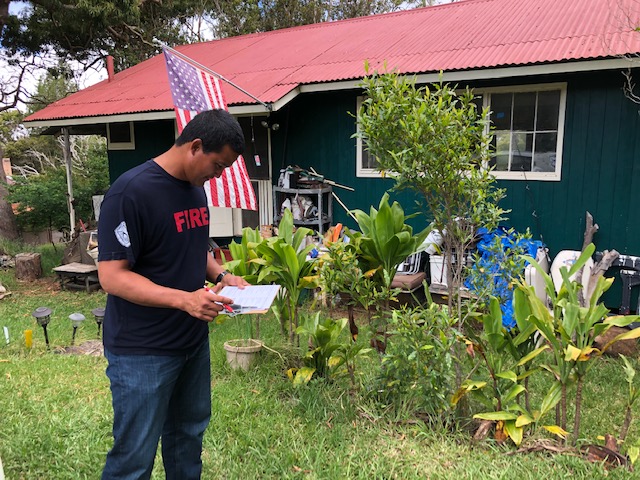Fifteen Years Firewise:
Kohala By the Sea Recognized for 15 Years of Community Wildfire Prevention Efforts
By: Jane Mayo, Nani Baretto, Elizabeth Pickett, Zoe Sims, and David Tarnas
On a sunny, breezy morning in late February, a group of Kohala residents gathered in the South Kohala Fire Station to celebrate 15 years of Firewise USA status for the community of Kohala By the Sea.
Located a few miles north of Kawaihae Harbor and just mauka of Akoni Pule Highway, Kohala By the Sea (KBTS) is a residential community of 48 homes nestled amidst Kohala’s arid, fire-prone grasslands. In 2004, KBTS was the first community in the State of Hawaii to be recognized by the National Fire Protection Association's Firewise USA program, which empowers neighbors to work together and take action to protect their homes from wildfire. When established, KBTS became the 50th Firewise Community nationwide. Today, KBTS is among more than 1,500 Firewise USA sites, including 14 in Hawaii. Its status as the state's longest-standing Firewise USA community is the result of years of collaboration between KBTS neighbors, the Hawaii County Fire Department, the Hawaii Wildfire Management Organization, and State leaders.
Representative David Tarnas speaking to residents of Kohala by the Sea
(Photo courtesy of Rep. Tarnas and Zoe Sims)
"As a community, you have recognized the serious risk wildfire poses to your community, and decided to take action," said State Representative David Tarnas (House District 7 – North & South Kohala, North Kona), who addressed residents and stakeholders gathered at the South Kohala Fire Station on February 20. "I hope that your model of collaborative self-management and proactive fire prevention is an inspiration to other communities that they can work together to concretely reduce the risk of wildfire to their homes."
Surrounded by arid rangelands that grow dense vegetation in the winter rain and become brown and fire-prone in the summer, the communities along the leeward side of Hawaii Island are particularly vulnerable to wildfire.
It hasn’t always been this way: the island’s leeward slopes were once home to extensive native dry-forests. Since the introduction of herbivores and deforestation of the lowland slopes, however, invasive grasses, such as guinea grass and fountaingrass, have come to dominate the landscape. These African savanna grasses have evolved to coexist with grazing herbivores and with periodic fire. The grasses dry easily, burn readily, and bear seeds resistant to fire.
The impacts of wildfires on lowland ecosystems are broad and long-lasting, according to Hawaii Wildfire Management Organization (HWMO), a nonprofit based in Waimea, Hawaii Island, that supports wildfire prevention and protection across the Pacific. Wildfire leaves slopes denuded of vegetation, so that subsequent rains sweep topsoil away, eroding the landscape and polluting near-shore waters with sediment and nutrients. Such sedimentation and nutrient enrichment is highly destructive to coastal water quality, coral reefs, and fisheries.
Concrete actions such as removing leaf litter and other flammable debris near homes, planting native drought-tolerant ground cover in place of invasive grasses and trees, and establishing home and community fire response plans, can significantly reduce communities' fire risks.
The Firewise USA program recognizes community-wide efforts to undertake such actions, educate residents regarding fire hazards, and collaborate with fire prevention stakeholders. KBTS has held work days to remove flammable debris, conducted semi-annual reviews to identify and reduce fire fuel; established a "Call-Em-All" system to contact residents in case of emergencies; and even created a digital community map with information to support fire response.
With the assistance of HWMO and the commitment of community members, Hawaiʻi Island’s leeward communities of Waikoloa Village, Waialea, Puako, Kohala Waterfront, Kanehoa, Waiki'i Ranch, and Pu'ukapu Pastoral have all followed KBTS to achieve Firewise status, and the community of Pu'uanahulu is expected to join them within the next few months.
Assistant Fire Chief Darwin Okinaka
(Photo courtesy of Rep. Tarnas and Zoe Sims)
At the KBTS event recognizing fifteen years of Firewise Community certification, Assistant Fire Chief Darwin Okinaka represented the Fire Department, but firefighters normally based at the station were unable to attend: they were busy responding to a brush fire in the Kawaihae area which broke out on the morning of February 20, and, according to Big Island Now, scorched about ten acres of coastline before being contained.
Addressing residents, Chief Okinaka said the Fire Department is grateful for the collaboration which is so key to reducing risk in communities.
Mike Walker with Smokey Bear presenting the 15 year Firewise signs
(Photo courtesy of Rep. Tarnas and Zoe Sims)
State Division of Forestry and Wildlife Fire Protection Forester Mike Walker said in his remarks that public involvement is key to protecting natural resources, such as soil, watersheds, and coastal water quality, from damages caused by wildfire.
"Establishing certain neighborhood protocols to mitigate the risk of wildfires causing destruction within your community is something that every community should practice," Carson Magoon, HWMO Community Education Coordinator, told KBTS residents. "Your methods in doing this are inspiring, and the community involvement you have all been able to maintain throughout the years is extraordinary. You and your neighbors have set an excellent example for the rest of state of Hawaii to follow."
For more information about our Firewise program, visit our Firewise Page here.





































































































